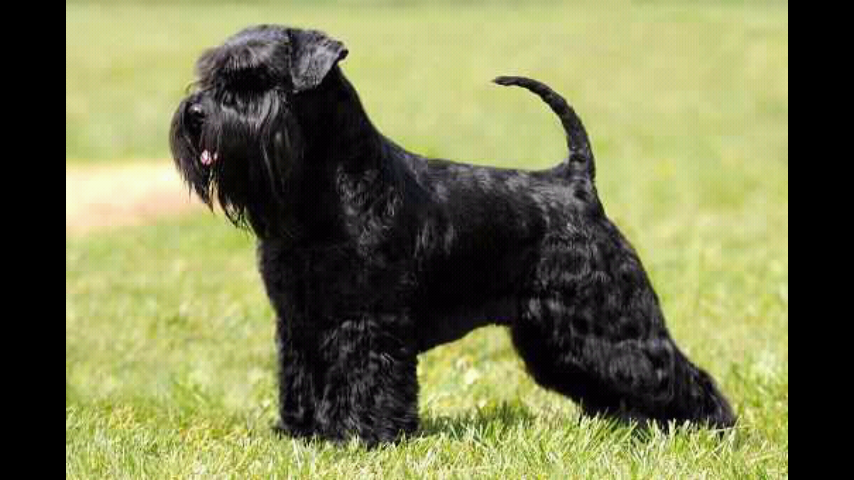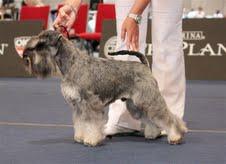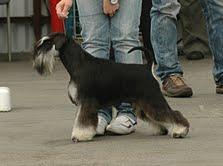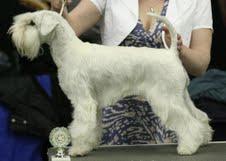
Schnauzers
Schnauzers
Schnauzers belong to very old dog breeds. The origin of the breed is still unknown but it is evident that the breed arose in the 15th century in Germany. The rats hunting, guarding of horses and stables were the original purposes of the breed. It didn´t depend on colour and type of hairs even on the size of the dog. The dog had to be persistent, hardy, energetic and have sense for property defence.
First interest in Schnauzer breeding appeared in 1878. In 1880 the first breeding characteristics were established. In 1917 the wirehaired Pinscher was officially named as Schnauzer. The original schnauzer breed was mostly kept in medium size and in various colours. On the contemporary exhibitions dogs of different colours and types of hairs were participated but steel gray hairs or silver color with beard and eyebrows were favoured.
Today's Schnauzer came into existence through a successive selection of suitable individuals for breeding. Nowadays the Schnauzer breed is kept in three variations - giant, medium and small Schnauzer.
Interbreeding of the medium Schnauzer led to large and small schnauzer. Giant Schnauzer originated from larger medium Schnauzer and heavy watchdogs from Bavaria interbreedings. Standard Poodle and black Great Dane were used in the process of Giant Schnauzer interbreeding. This interbreeding was banned in 1925. Today's Miniature Schnauzer originated from crossing smaller individuals of medium Schnauzer and small stable rough coated Pinscher.
Thanks to Schnauzer genetic characteristics - liking of hunting, aggression, alertness, focus and independence - they are perfectly well trained to become service dogs, avalanche, assistant and defensive.
Coat colors in Schnauzers
All Schnauzers carry i/i genotype in locus I.
|
Genotype |
Main coat color |
Carrier of colour |
|
EEKBKB |
black |
- |
|
EEKBkyawaw |
black |
salt-and-pepper |
|
EEKBkyawat |
black |
salt-and-pepper, black-and-silver |
|
EEKBkyawa |
black |
salt-and-pepper, recessive black |
|
EEKBkyatat |
black |
black-and-silver |
|
EEKBkyata |
black |
black-and-silver, recessive black |
|
EeKBKB |
black |
white |
|
EeKBkyawaw |
black |
white, salt-and-pepper |
|
EeKBkyawat |
black |
white, salt-and-pepper, black-and-silver |
|
EeKBkyawa |
black |
white, salt-and-pepper, recessive black |
|
EeKBkyatat |
black |
white, black-and-silver |
|
EeKBkyata |
black |
white, black-and-silver, recessive black |
|
eeKBKB |
white |
black |
|
eeKBkyawaw |
white |
black, salt-and-pepper |
|
eeKBkyawat |
white |
black, salt-and-pepper, black-and-silver |
|
eeKBkyawa |
white |
black, salt-and-pepper, recessive black |
|
eeKBkyatat |
white |
black, black-and-silver |
|
eeKBkyata |
white |
black, black-and-silver, recessive black |
|
eekykyawaw |
white |
salt-and-pepper |
|
eekykyawat |
white |
salt-and-pepper, black-and-silver |
|
eekykyawa |
white |
salt-and-pepper, recessive black |
|
eekykyatat |
white |
black-and-silver |
|
eekykyata |
white |
black-and-silver, recessive black |
|
EEkykyawaw |
salt-and-pepper |
- |
|
EEkykyawat |
salt-and-pepper |
black-and-silver |
|
EEkykyawa |
salt-and-pepper |
recessive black |
|
EEkykyatat |
black-and-silver |
- |
|
EEkykyata |
black-and-silver |
recessive black |
|
Eekykyawaw |
salt-and-pepper |
white |
|
Eekykyawat |
salt-and-pepper |
white, black-and-silver |
|
Eekykyawa |
salt-and-pepper |
white, recessive black |
|
Eekykyatat |
black-and-silver |
white |
|
Eekykyata |
black-and-silver |
white, recessive black |
.
The schnauzer breeds occur in various colour shades, see table.
The basic colour of Miniature Schnauzer is solid black with black undercoat, salt and pepper, black and silver, solid white with white undercoat.
The basic colour of Standard Schnauzer - pure black with black undercoat, salt and pepper.
The basic colour of Giant Schnauzer - pure black with black undercoat, salt and pepper
Black coat
The coat of solid black schnauzers shall be bright black hair, but we can often see reddish stained beard and eyebrows that is not desired.

.
Salt and pepper
The salt-and-pepper colour of the topcoat is the original colour of dogs, so-called agouti pattern. The aim in breeding is the medium shade with regular alternation of pigmented and non-pigmented part of a hair, giving it a salt and pepper appearance. Acceptable are all shades of salt and pepper from dark steel grey to silver grey. The darker and lighter areas should be spread uniformly over the body. The salt and pepper dogs shall have dark mask, where the white marks on the head, chest and limbs are undesirable.

Photo: salt-and-peper dog, genotype kyky, aw/aw (aw/at), i/i
.
Black and Silver
The black and silver coat colour is acceptable only in Miniature Schnauzer. The first black and silver dogs were bred from the salt and pepper dogs. The black and silver colour was accepted in 80´s of the 20th century. The aim of the breeders is a true rich black of the topcoat with black undercoat with white marks over the eyes, on the cheeks, at the beards, at the throat, in two divided triangles at the front of the chest, on the front pasterns, on the feet, o the inside of the hind legs and around the anus. The forehead, the neck and the outer side of ears should be black like the topcoat.

Photo: black and silver dog, genotype: kyky, at/at, i/i
.
White coat
The white coat colour occurred even earlier than the black and silver colour, where the white dogs were probably a result of mutations. For the first time, they were imported to the Czech Republic in the 80´s of 20th century from the German breeding stations.
The fur of the white schnauzer is free of pigments, it does not contain white colour, but it is colourless. The space in the keratinous layer of a hair is filled with air instead of a pigment and it results in white colour. The hair of a white schnauzer not so harsh and the fur is much finer than in schnauzers with different colour. Although the white schnauzers do not store the pigment in the hair, they store the pigment in the skin. If a white schnauzer has a red pigment pheomalinin, a red eel-like band may occur on the back.

Photo: black and silver dog, genotype of locus E: e/e


